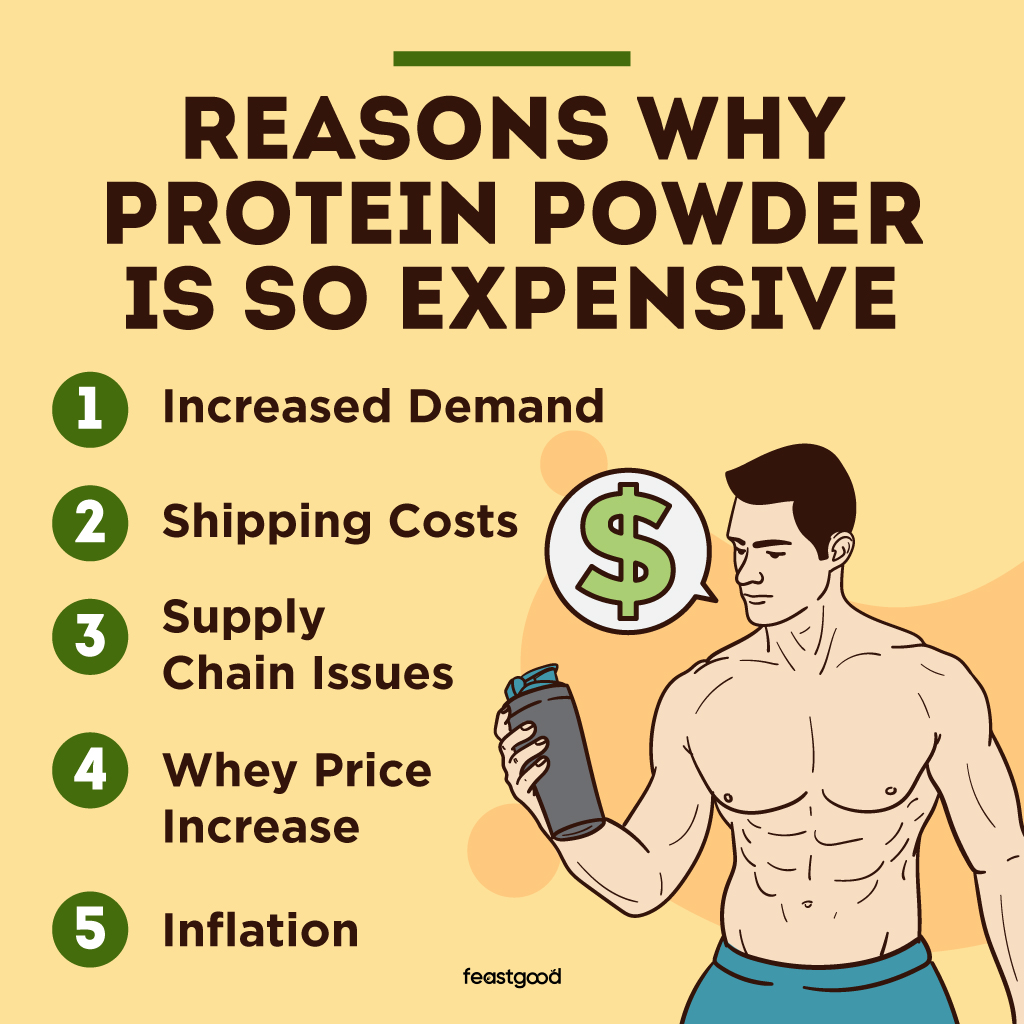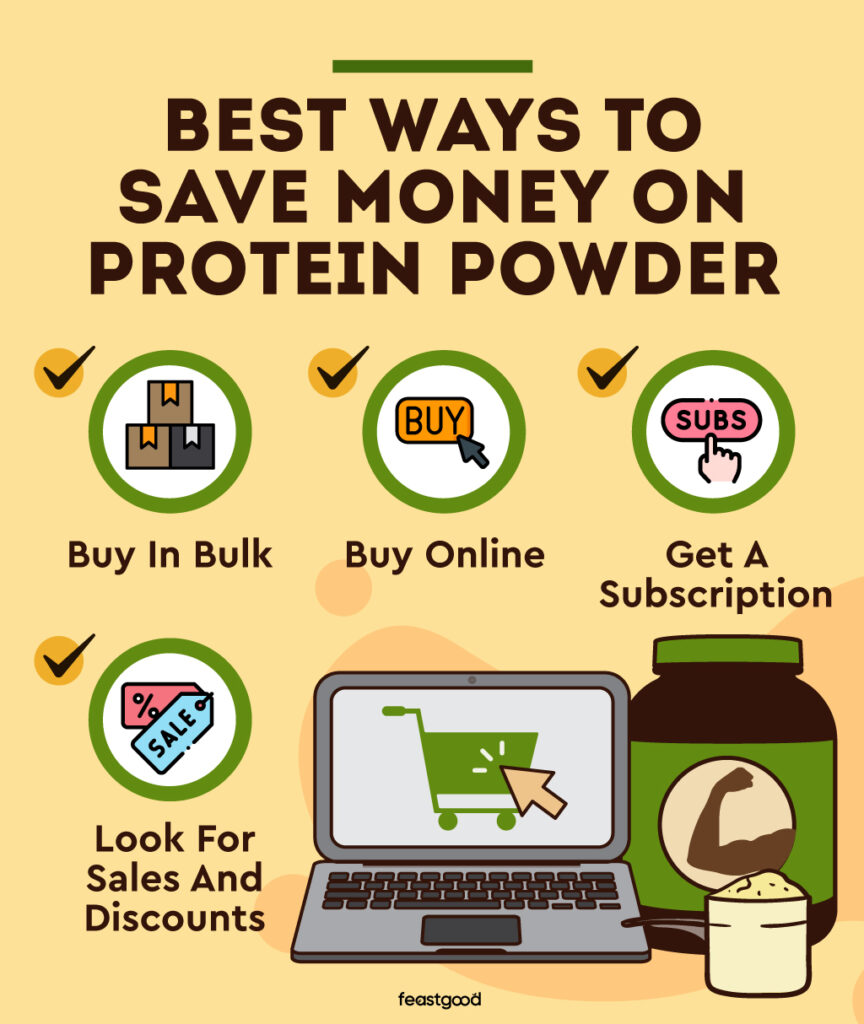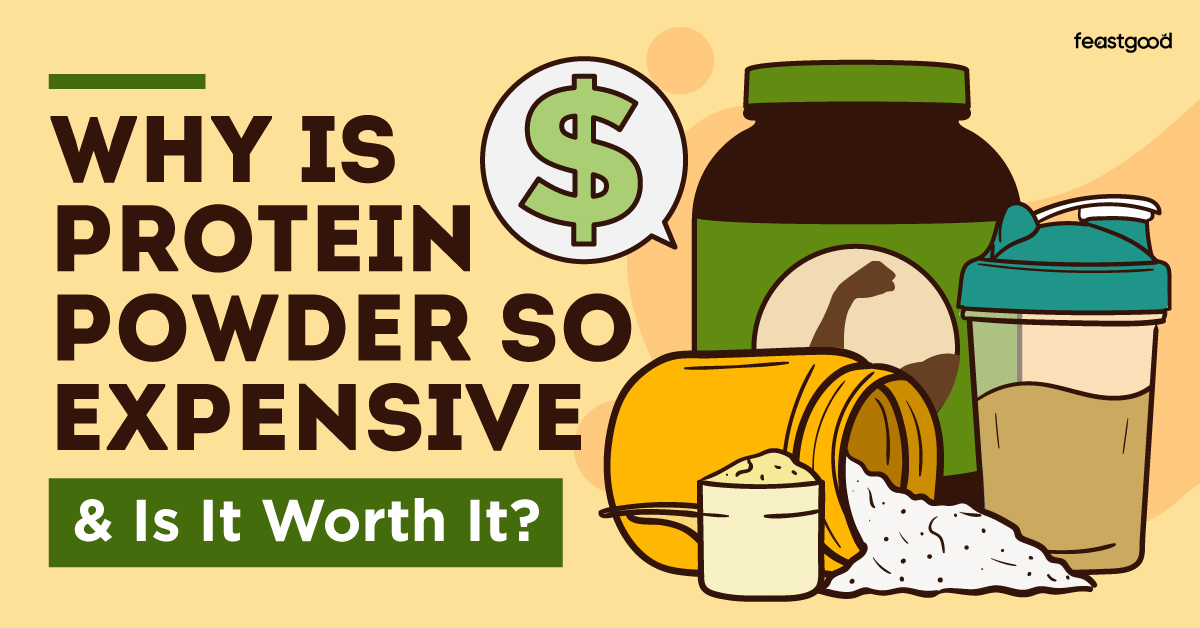Some links in this article are affiliate links, which means we earn from qualifying purchases. Learn more.
If you’re buying protein powder for the first time, you might have some “sticker shock” about how high the price is, or if you’re like me and you’ve been using it for years, you’re frustrated with how much the price has recently increased. Below, I’ll explain why that’s the case and some factors to consider when deciding whether a protein powder is worth it or not.
Key Takeaways
- According to data that FeastGood.com obtained from Pure Source, a national manufacturer and distributor of supplements, protein powder prices have increased by 16% from 2023 to 2024. The main reasons are increased demand, shipping costs, supply chain issues, whey manufacturing costs, and inflation.
- It’s still worth paying a premium for protein powder if it is third-party tested, has a high protein percentage (above 85%), does not contain artificial sweeteners or fillers, and includes additional supplements you would otherwise pay for separately.
- The best ways to save money on protein powder are to buy in bulk, buy online, buy on a subscription basis, and look for sales, discounts, and promotions.
Looking for the cheapest whey protein powder? Check out our round-up of the 8 Cheapest Protein Powders (that are still high quality).
Protein Powder By The Numbers
My colleague Jennifer Vibert, who does all of our supplement and protein powder reviews, has been a supplement store manager for over a decade. In those ten years, she’s been able to monitor price trends for various supplements, including protein powder.
Jenn’s access to product catalogs and pricing over the past several years gives us unique data at FeastGood to provide expert explanations and advice on protein powder.
Jenn gets most of her data from Pure Source, a national manufacturer and distributor of supplements and health food products across Canada.
Note: We are using Canadian data because Jenn lives in Canada, but the same stats apply across North America, including the U.S.
In the last few years, the price of protein powder has skyrocketed.
Here is the data for November 2022 vs. November 2023:
| Product | 2022 Price | 2023 Price | % increase |
|---|---|---|---|
| Egg white protein | $35.18 | $39.05 | 11% |
| Pea protein | $32.46 | $35.71 | 10% |
| Whey Isolate Unflavored 544 g | $30.02 | $36.02 | 20% |
| Whey Isolate Unflavored 2268 g | $99.02 | $118.82 | 20% |
| Whey Isolate Flavored 816 g | $36.84 | $44.21 | 20% |
The data shows an average increase of 16% in just the last 12 months.
What was once an affordable option is now a purchase you may think twice about.
For example, Optimum Nutrition (ON) Gold Standard Whey is considered one of the more budget-friendly options, and it still costs $44.99 for 2 lbs.
Using the “Wayback Machine” (an internet archival feature), I was able to track price trends for this product over the last seven years (and you can do the same thing for your favorite supplements, too).
Optimum Nutrition 100 Gold Standard Whey Protein Powder:
| Year | Price for 2 lbs | % increase 1-year | % increase from 2016 |
|---|---|---|---|
| 2016 | $29.99 | N/A | N/A |
| 2017 | $29.99 | 0% | 0% |
| 2018 | $29.99 | 0% | 0% |
| 2019 | $30.99 | 3.33% | 3.33% |
| 2020 | $30.99 | 0% | 3.33% |
| 2021 | $30.99 | 0% | 3.33% |
| 2022 | $44.99 | 45% | 50% |
| 2023 | $44.99 | 45% | 50% |
You can see that the price increased by 50% in 2022 compared to 2016-2018 levels – that means you’re paying one and a half times more for the same amount of product!
What Is Considered An “Expensive” Protein Powder According To Today’s Standards?
The average cost for a serving of protein powder as of January 2024 is $1.34. At FeastGood, we consider “expensive” protein powder to be $1.50 per serving or more.
While it’s tempting to go for a cheaper option like Six Star ($1.00/serving) instead of a product like Transparent Labs ($2.00/serving), the higher price point is worth it based on the difference in quality.
That said, a higher price doesn’t always indicate a better product, so understanding which criteria make a protein powder worth paying more for is essential.
If a protein powder meets the following criteria, then it is worth paying more than average:
- Third-party tested and certified
- At least 90% protein per serving (as a percentage of total calories)
- No sugar alcohols, artificial flavors, or fillers
- Inclusion of additional supplements that you would otherwise pay for separately (as long as the amount per serving is disclosed and stated on the label)
I’ll explain this in further detail later on.
Five Reasons Why Protein Powder Is So Expensive

Here are the top five factors contributing to the increase in the price of protein powder:
Reason #1: Increased Demand
The fundamentals of economics, supply and demand, apply to the protein powder industry just as they do elsewhere. The higher the demand, the higher the price.
Amber French, the Purchasing Manager for Bulk Supplements, explains why protein powder use is going up:
“The consumption of protein-rich diets has increased largely over the past few years due to rising health awareness among consumers worldwide. Nutritionally rich, complete diets are challenging to achieve for consumers regularly, so they look for nutrients contained in packaged foods such as protein rich foods or ingredients.
Fitness trends are a critical driving factor for the increase in protein ingredients such as whey, soy, pea etc. These types of protein powders provide consumers convenience for creating protein shakes or blending them with several food products.”
As more and more people become interested in improving their health and fitness, they will want to buy protein powder and are willing to pay more to get their hands on it.
Reason #2: Shipping Costs
We can turn to another industry expert, Bulk Nutrients founder Ben Crowley, who explains:
“Shipping has increased by a whopping 5x compared to 2018 pricing…the shipping issue is made even worse as companies compete to get space on ships. Not only are goods far more expensive to ship, but everything is taking far longer to move around. What used to take 6 weeks from order to delivery in a shipping container, may now take up to 26 weeks!”
Supplement company MyProtein also noted that “there is a shortage of truck drivers, making product transportation much more difficult and expensive.”
Plus, many new retailers now offer product delivery services because of the significant shift to online shopping during the COVID pandemic.
This trend hasn’t reversed and is likely to grow, meaning there is even more demand for shipping services, driving up prices for everyone.
Even if the cost of raw materials for making protein powder remained the same (which it hasn’t – see more below), the higher shipping costs alone would translate into higher prices for the final product.
Reason #3: Supply Chain Issues
On top of increased demand and higher shipping costs, the whey protein market was impacted indirectly, but still significantly, by lockdowns during the global pandemic.
Many dairy farms laid off staff and reduced their operations during the lockdowns, resulting in lower output from the dairy industry and less whey for making whey protein powder.
Most of the whey for whey protein powder is the byproduct of manufacturing cheese, and cheese consumption also decreased during the pandemic because the major customers (restaurants) shut down.
Dairy producers shifted their focus away from making cheese due to the lower demand for cheese, resulting in even less whey for protein production.
The cost of fertilizer and grain also increased, making it more costly to feed and raise cows. These price adjustments increased the cost of milk even further, impacting the cost of whey protein.
Even the packaging for whey protein powder increased, as many plastic manufacturers focused on creating plastic face masks and flexible shields and screens.
Reason #4: Whey Price Increase
Like the supply and demand considerations I discussed above, all factors contributing to a lower supply of whey mean higher prices.
The higher cost of packaging materials and other raw ingredients leads to sharp increases in the price of whey protein powder.
Reason #5: Inflation
Finally, inflation, in general, impacted the price of protein powders. Inflation peaked at around 9% in mid-2022, capping off a trend of above-average inflation that started in April 2021 and continued to the beginning of 2023.
Many manufacturers and retailers had to raise their prices to stay in business. But, even when inflation rates go down, product pricing often does not follow suit, at least not immediately. Once customers adapt to the higher price, many companies opt to keep their prices higher for as long as possible.
Future Protein Pricing: Are They Expected To Stabilize, Decrease, or Continue To Rise?
It’s unclear what will happen to protein pricing in the future. Amber French gives her perspective, stating:
“I anticipate demand will still be strong and pricing will be stable into 2024, unless unforeseen supply chain disruptions occur.”
However, some locations have already benefited from price drops compared to the peaks in 2022. Many consumers turned away from high-priced whey protein powder and opted for plant-based protein powders, which saw more modest price increases (consistent with our data table).
This dip in demand for whey protein specifically led to an easing of prices on whey protein powder.
With more and more restaurants up and running again, cheese production has increased, making more whey available and offsetting the supply shrinkage in the past years.
So, while prices for protein powders will be relatively stable, keep an eye on your favorite whey protein powders. Since businesses generally don’t like to lower their base prices once they’ve raised them, they can still pass savings to their customers by offering more frequent sales and discounts rather than dropping the price altogether.
Cheap vs. Expensive Protein Powder: Does More Money Equal Better Quality?
Does more money equal better quality when it comes to protein powders? The answer is that it depends.
Transparent Labs’ Grass-Fed Whey Protein Isolate is the highest-priced protein powder we’ve reviewed. It costs around $2 per serving compared to the industry average of $1.34, but it’s well worth it for the following reasons:
- 93% protein as a percentage of total calories, compared to 75-85% for most other protein powders.
- Twelve flavor options, using only natural flavors and sweetened with stevia instead of sugar alcohols or other high-intensity sweeteners like aspartame or sucralose.
- 3rd-party tested, with Certificates of Analysis available for every batch tested.
However, other high-priced protein powders aren’t necessarily higher quality than lower-priced options.
For example, Ghost Protein costs $1.73 per serving (vs. the average $1.34), but it’s artificially sweetened, only has 80% protein per calorie, and doesn’t offer certificates of analysis for 3rd party-testing, so this product doesn’t seem worth the price.
Furthermore, the lowest-priced protein powder we’ve reviewed, from Bulk Supplements, costs less than $1 per serving, has 90% protein per calorie, and is third-party certified.
All this is to say that price doesn’t determine quality, so research a product’s protein content, ingredients, and reputation before purchasing.
Four Best Ways To Save Money On Protein Powder

1. Buy In Bulk
My first tip for saving money on protein powder is to buy it in bulk once you find a product you like.
To start, I suggest getting sample-size servings to figure out what brand, type, and protein flavor you like best so you don’t waste your money buying an entire tub for something you hate.
Once you know what brand, type, and flavor of protein powder you like best, buy the largest size you can. Most protein powders have a very long shelf life (1-2 years or more) if properly stored.
I personally like to buy “basic” flavors like vanilla or chocolate (or even unflavored) so that I have more versatility when using them in recipes and adding additional ingredients to change the flavor, compared to buying specialty flavors that might not work with anything else (like Fruity Pebbles or Banana Milkshake).
You will pay more upfront for a large package, but the cost per serving will be less. Be sure to do the math to check.
For example, if a 5-lb container of protein powder costs $75, that’s $15 per pound and about $0.94 per ounce. For a 3-lb container of the same protein powder, the price might be $60, $20 per pound, or $1.25 per ounce. You pay $15 more upfront, but it’s a significant savings per serving.
2. Buy Online
My next tip is to buy protein powder online.
Some companies that sell exclusively online versus managing “bricks and mortar” storefronts have lower costs and can pass that along in terms of lower product costs to their customers.
Many brands offer free shipping if you meet a minimum order threshold, so take advantage of this offering by buying a larger size or ordering other supplements you plan to use.
3. Get A Subscription
Repeat business is good for companies and can benefit you as a customer.
If you find a product you know you will continue to use, sign up for a subscription service to deliver the product at a specified frequency.
A recurring purchase will get you a better price than a one-time purchase of the same product.
4. Look For Sales And Discounts
You can also save money by looking for coupon codes, sales, and discounts, like a buy one, get one free promotion. Like other retailers, supplement companies often have seasonal promotions like Black Friday sales.
Certain websites also have “Specials” or “Clearance” sections for product flavors that weren’t as popular as they’d hoped or those approaching their expiration date. If you know you can use it up before it expires, you can get a good deal (but don’t use expired protein powder).
Lastly, many supplement companies have sponsored athletes who offer discount codes that save 10-15% on your order. A quick Instagram search can help you identify these athletes and their discount codes.
Frequently Asked Questions
Is the Cost Of Protein Powder Worth It?
Whether the protein powder cost is worth it depends on your goals, preferences, and budgets.
There are many lower-cost whole-food protein sources, such as canned fish, deli meats, egg whites, Greek yogurt, or beans and legumes if you also want carbs, but these are less convenient than protein powder.
What Is The Most Expensive Protein Powder?
The most expensive protein powder is Steadfast Nutrition WARMAX Protein, a blend of isolate and hydrolysate with added BCAAs, L-carnitine, rose hip extract, and digestive enzymes.
Prices vary but can be more than $6 per 40 g sachet (one serving with 32 g of protein). Most protein powders are less than $2 per serving.
What Is The Least Expensive Protein Powder?
The best budget protein powder is Bulk Supplements Whey Protein Concentrate.
Their facility is 3rd-party certified, so you can trust you are still getting the amount of protein stated on the label. If you find cheaper protein powder, it likely contains fillers like starches that reduce the amount of protein per scoop.
What To Read Next
References
Shaw N, Eschenbrenner B, Baier D. Online shopping continuance after COVID-19: A comparison of Canada, Germany and the United States. Journal of Retailing and Consumer Services. 2022 Nov;69:103100. doi: 10.1016/j.jretconser.2022.103100. Epub 2022 Aug 16. PMCID: PMC9379614.
Pure Source Natural Wellness Products Distributor. Retrieved from https://puresource.ca/
About The Author

Lauren Graham is a Precision Nutrition Level 1 certified nutrition coach. She focuses on helping busy professionals balance healthy eating and purposeful movement. Lauren has a background in competitive swimming and is currently competing as a CrossFit athlete. She has a passion for training, teaching, and writing.
Why Trust Our Content

On Staff at FeastGood.com, we have Registered Dietitians, coaches with PhDs in Human Nutrition, and internationally ranked athletes who contribute to our editorial process. This includes research, writing, editing, fact-checking, and product testing/reviews. At a bare minimum, all authors must be certified nutrition coaches by either the National Academy of Sports Medicine, International Sport Sciences Association, or Precision Nutrition. Learn more about our team here.
Have a Question?
If you have any questions or feedback about what you’ve read, you can reach out to us at [email protected]. We respond to every email within 1 business day.
